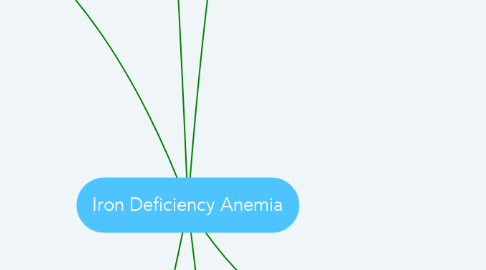
1. Causative Factors
1.1. Living conditions
1.1.1. poverty
1.1.2. underdeveloped countries
1.1.3. underserved communities
1.2. Parasitic infections
1.2.1. Schistosomiasis
1.2.2. Ancylostoma duodenale
1.2.3. Necator americanus
1.3. Pregnancy
1.3.1. increased blood volume requires more hemoglobin
1.3.2. growing fetus requires hemoglobin from mother
1.4. Diet
1.4.1. vegetarian
1.4.2. vegan
1.4.3. "raw" vegan
1.5. Chronic blood loss
1.5.1. heavy menstruation
1.5.2. hemodialysis
1.5.2.1. minute blood loss occurs during every treatment
1.5.3. gastrointestinal bleeding
1.5.3.1. peptic ulcers
1.5.3.2. colon polyps
1.5.3.3. colorectal carcinoma
1.6. Malabsorption disorders
1.6.1. celiac disease
2. Diagnostic Testing
2.1. Lab values
2.1.1. hemoglobin
2.1.1.1. chronically low levels reflect anemia of some sort
2.1.2. reticulocyte hemoglobin concentration (CHr)
2.1.2.1. underused
2.1.2.2. iron availability for hemoglobin synthesis
2.1.2.3. low values reflect iron deficiency anemia
2.1.2.4. low levels are also indicative of other disorders
2.1.3. soluble transferrin receptor level (sTfL)
2.1.3.1. often underused
2.1.3.2. expresses TfR gene
2.1.3.3. used to distinguish between inflammation and true iron deficiency anemia
2.1.4. reticulocyte count
2.1.4.1. usually overlooked if HgB is low
2.1.4.2. pertinent in diagnosis of anemia
2.1.4.3. best if deciphered early on
2.1.5. red cell indices
2.1.5.1. changes in amount of HgB in red blood cells
2.1.5.2. in severe iron deficiency
2.1.5.3. represents fall in mean corpuscular volume (MCV)
2.1.5.4. represents a fall in low mean corpuscular hemoglobin concentration (MCHC)
2.1.6. serum ferritin
2.1.7. transferrin iron binding capacity (TIBC)
2.1.7.1. iron stores for hemoglobin synthesis
2.1.7.2. used with serum iron to create percent transferrin saturation
2.1.7.3. 16-20% represent mild to moderate inadequacy
2.1.7.4. less than 15% is indicative of iron deficiency anemia
3. Common Findings
3.1. Brittle nails &/or hair
3.2. Pica
3.2.1. craving &/or eating
3.2.1.1. dirt
3.2.1.2. clay
3.2.1.3. paint
3.2.1.4. laundry detergent
3.2.1.5. starches
3.2.1.6. ice
3.3. Fatigue
3.4. Perfusion complaints
3.4.1. dizziness
3.4.2. delayed capillary refill
3.4.3. pallor
3.4.4. light-headedness
3.5. Respiratory complaints
3.5.1. dyspnea
3.5.2. exertional dyspnea
3.6. Cardiac complaints
3.6.1. chest pain
3.6.2. tachycardia
3.7. Poor appetite
3.7.1. infants
3.7.2. children
3.8. Oral and tongue abnormalities
4. Pathophysiology
4.1. Decrease in the oxygen carrying capacity of blood
4.1.1. Iron
4.1.1.1. Reduction of iron stores
4.1.1.1.1. decrease in iron = decrease in red blood cell (RBC) production
4.1.1.2. crucial for daily human function
4.1.1.3. respiratory gas exchange
4.1.1.4. production of energy
4.1.1.5. DNA synthesis
4.1.1.6. cell proliferation
4.1.1.7. acquisition of iron
4.1.1.7.1. regulated by Hepcidin-based homeostasis
4.1.2. Translates into anemia
4.1.2.1. Iron deficiency anemia is the most common type of anemia worldwide
4.1.2.1.1. affects well over 2 billion internationally
4.1.2.1.2. highest prevalence seen in central and west Africa and south Asia
4.1.2.1.3. iron deficiency is main cause of anemia
4.1.2.2. decrease in RBC mass
4.1.2.2.1. function of RBC
4.1.2.3. HgB of 8 or less
4.1.2.3.1. inflammatory cytokines, especially interleukin-6, play a large role
4.1.2.4. Less than 6 is considered severe anemia
5. Risk Factors
5.1. Gender
5.1.1. women have increased risk
5.2. Frequent blood donation
5.3. Pediatric population
5.3.1. infants have higher risk
5.4. GI disturbances
5.5. Low meat diets
6. Treatments
6.1. Oral iron replacement
6.1.1. easy solution
6.1.2. inexpensive
6.1.3. easy to obtain
6.1.4. causes dark stool and mild GI issues
6.2. Treating the underlying cause
6.3. Parenteral iron replacement
6.3.1. very effective
6.3.2. administered to those that are not responsive to oral supplementation
6.3.3. higher associated risks than oral iron
6.3.3.1. anaphylactic shock
6.3.3.2. potential death
6.4. Education
6.4.1. prevention programs have shown to decrease incidence of iron deficiency anemia in underdeveloped countries worldwide

